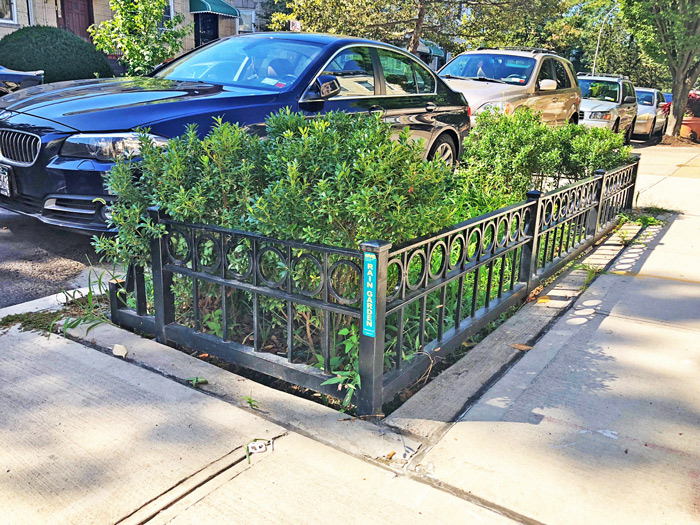Forum Photo by Michael V. Cusenza
The rain gardens, like this one in Ridgewood, are designed so that all the stormwater is absorbed in less than 48 hours.
By Michael V. Cusenza
The City has begun construction on more than 5,000 specially designed curbside rain gardens in Queens, Brooklyn, and the Bronx, building upon the more than 4,000 rain gardens that have already been built. This construction will bring a total of more than 9,000 curbside rain gardens these boroughs, helping to prevent flooding and reduce Combined Sewer Overflows into local waterways by more than 500 million gallons each year, the de Blasio administration recently announced.
According to the City, more than 70 percent of the Big Apple’s land mass is covered by an impervious surface, which creates tremendous volumes of stormwater entering the sewer system during rainstorms. Curbside rain gardens help to soften the city’s landscape and allow the stormwater to be naturally absorbed into the ground, therefore reducing flooding that can impact roadways, homes and businesses. By keeping stormwater out of the city’s combined sewer system, where it can contribute to combined sewer overflows into local waterways, the rain gardens serve as a tool to improve the health of local waterways, Mayor Bill de Blasio noted.
“We are deploying all of the resources at our disposal to tackle the challenge of global warming head-on,” Hizzoner added. “We are doubling the size of the largest green infrastructure program in the country, creating green oases in our neighborhoods and protecting our waterways for all New Yorkers to enjoy.”
According to the City Department of Environmental Protection, rain gardens are built in city sidewalks and do not result in the loss of any parking spaces. They resemble standard street tree pits, except that they vary in size, have curb cuts that allow stormwater to enter and overflow if it becomes saturated, and have been engineered in a way that will allow them to manage up to 2,500 gallons each during a storm. In partnership with the departments of Transportation and Parks and Recreation, DEP conducts an extensive site selection process that includes geotechnical investigations and surveys. The rain gardens are designed so that all the stormwater is absorbed in less than 48 hours and dedicated maintenance crews ensure that they are functioning properly, including removing any trash that may have accumulated and pruning the trees and plants. The crews are active seven days a week, visit each rain garden approximately once a week and additional crews will continue to be added as the program expands.
However, it’s not all sunshine and rainbows when it comes to rain gardens. They are magnets for trash and illegal dumping. And many are not maintained nearly as frequently as the administration has indicated.
Still, the positive effects of the City’s concerted effort to significantly add to NYC’s green infrastructure cannot be denied.
“The Jamaica Bay Ecowatchers have worked with DEP over the last decade to help restore wetlands habitat and water quality throughout Jamaica Bay,” said JBE President Dan Mundy. “Today we are experiencing the best water quality in over a hundred years and this has resulted in a resurgence of large marine life including dolphins and seals returning to the waters of Jamaica Bay. One of the last great challenges is addressing rain event sewer overflows and these rain gardens will have a huge impact on such events.”

